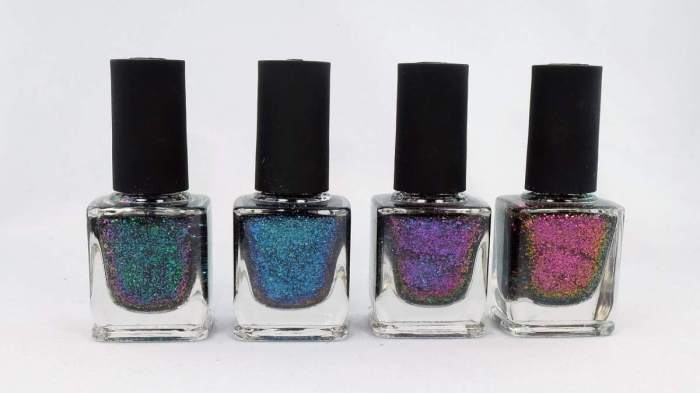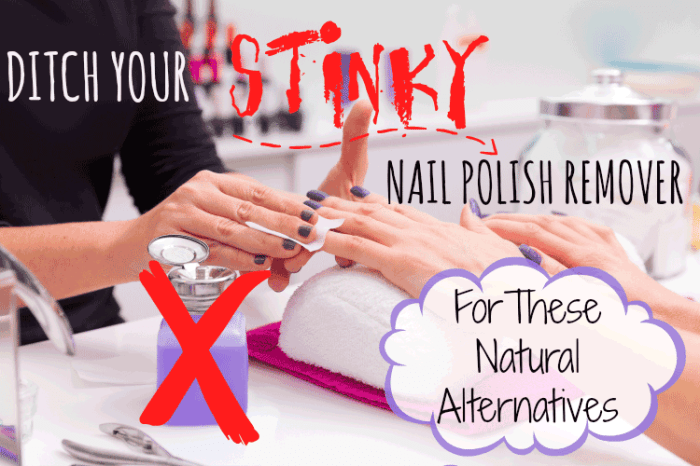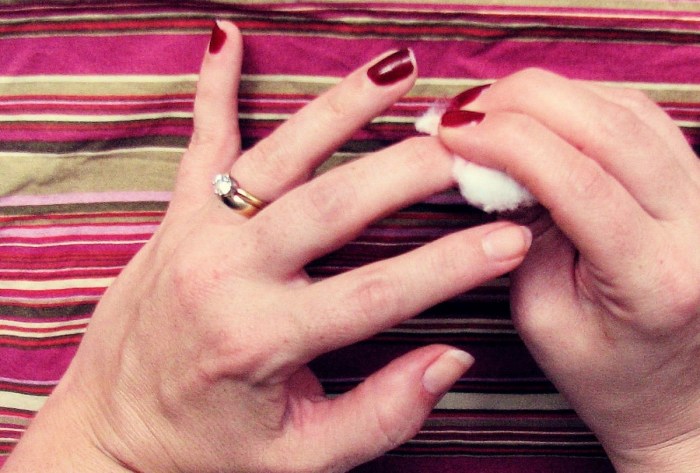Alternatives for Nail Polish Remover
Natural Nail Polish Removers
Alternatives for nail polish remover – Removing nail polish doesn’t always require harsh chemicals. Natural alternatives offer a gentler approach, minimizing potential damage to nails and surrounding skin. This section explores the benefits and drawbacks of natural nail polish removers, comparing them to acetone-based options and providing a recipe for a homemade solution.
Common Natural Ingredients for Nail Polish Remover
Several natural ingredients effectively dissolve nail polish. However, their effectiveness varies depending on the type of polish and the concentration of the ingredient. It’s crucial to consider both benefits and potential drawbacks before use.
- Acetone-Free Nail Polish Remover: While not strictly a “natural” ingredient, many commercial acetone-free removers utilize gentler solvents and are a better option than pure acetone. They’re generally less harsh on nails but may require more rubbing to remove polish.
- White Vinegar: Its acidity helps break down nail polish, but it can be drying to the skin and nails if used excessively.
- Lemon Juice: The citric acid in lemon juice offers a similar effect to vinegar, but its strong scent might be bothersome to some. Like vinegar, overuse can dry nails.
- Rubbing Alcohol (Isopropyl Alcohol): A relatively effective solvent, but it can also be drying to the skin and nails if used repeatedly.
- Vegetable Oils (Olive, Coconut, etc.): While not dissolving the polish directly, these oils can help soften and loosen it, making it easier to remove. They are gentler on the nails than other options but may not be effective on long-lasting or dark polishes.
Acetone-Based vs. Natural Nail Polish Removers
Acetone-based removers are highly effective due to acetone’s strong solvent properties. However, acetone is a harsh chemical that can dry out and damage nails, leading to brittleness and peeling. Natural alternatives, while less potent, are gentler and minimize this risk. The chemical difference lies in the molecular structure; acetone’s structure readily dissolves the polymers in nail polish, while natural ingredients typically rely on gentler acidic or solvent properties.
Homemade Natural Nail Polish Remover Recipe
This recipe combines the effectiveness of rubbing alcohol with the moisturizing properties of vegetable oil to create a gentler remover.
- Combine 1/4 cup rubbing alcohol (isopropyl alcohol) with 1/4 cup olive oil or coconut oil in a small bowl.
- Stir well to ensure the ingredients are thoroughly mixed.
- Pour the mixture into a small, airtight container.
- Saturate a cotton ball or pad with the mixture and gently wipe away the nail polish.
- Rinse your nails with warm water and moisturize.
Safety Precautions: Always test a small amount of the mixture on your skin before applying it to your nails. Avoid contact with eyes. Store the remover in a cool, dark place.
Acetone-Free Nail Polish Removers
Acetone-free nail polish removers offer a less harsh alternative to traditional formulations. While they may require more time and effort, they prioritize nail health and are preferred by many individuals.
Advantages and Disadvantages of Acetone-Free Removers
Acetone-free removers are gentler on nails and the surrounding skin, reducing dryness and brittleness. However, they are generally less effective at removing stubborn or long-lasting polishes and may require multiple applications. The slower removal process can also be a disadvantage for some.
Leading Brands of Acetone-Free Nail Polish Removers
Several brands specialize in acetone-free formulations, catering to various needs and preferences. The following are examples, and their features and target audiences may vary.
- Brand A: Often marketed towards those with sensitive skin, Brand A’s remover typically includes moisturizing ingredients to offset the drying effects of the solvents used.
- Brand B: Known for its fast-drying formula, Brand B focuses on efficiency without compromising on gentleness. It may appeal to users who prefer quick removal but want to avoid acetone.
- Brand C: This brand often incorporates natural ingredients, such as essential oils, into their acetone-free remover, providing both gentle removal and a pleasant scent. This might attract environmentally conscious consumers.
Consumer Reviews and Ratings of Acetone-Free Removers
Consumer opinions provide valuable insights into the performance and user experience of different products.
| Brand Name | Rating (Example) | Key Features |
|---|---|---|
| Brand A | 4.5 stars | Gentle, moisturizing, pleasant scent |
| Brand B | 4 stars | Fast-drying, effective on most polishes, slightly drying |
Methods for Removing Nail Polish Without Remover
In situations where commercial nail polish remover isn’t available, several alternative methods can effectively remove nail polish. These methods, however, may require more time and effort and might not be as effective on all types of nail polish.
Alternative Nail Polish Removal Methods
These methods utilize readily available household items to remove nail polish without relying on chemical removers. Effectiveness varies based on the type of nail polish and the individual’s technique.
- Method 1: Soaking in Warm, Soapy Water: This involves soaking nails in warm, soapy water for an extended period to soften the polish. The image would show hands submerged in a bowl of warm, soapy water. This method is most effective on lighter polishes and may require repeated soaking.
- Method 2: Using Toothpaste: A small amount of non-gel toothpaste can be gently rubbed onto the nails to help loosen and lift the polish. The image would show a person gently rubbing toothpaste onto their nails. This method works best on lighter colored polishes.
- Method 3: Using Baking Soda Paste: A paste of baking soda and water can be applied and gently scrubbed to remove polish. The image would show a person applying a baking soda paste to their nails. This method may be abrasive and should be used cautiously.
Step-by-Step Guide Using Household Items
This method uses only household items to remove nail polish. This method is not as effective as commercial removers and may damage nails with repeated use.
- Fill a bowl with warm, soapy water.
- Submerge your nails in the water for 10-15 minutes.
- Gently push the softened polish off with a wooden cuticle pusher or orangewood stick.
- Rinse your nails and moisturize.
Risks and Limitations of Remover-Free Removal
Removing nail polish without a remover can be more time-consuming and may not remove all traces of polish, especially darker or long-lasting formulas. The abrasive nature of some methods can damage the nail surface, leading to weakening and increased susceptibility to breakage.
Nail Polish Remover Alternatives for Sensitive Skin: Alternatives For Nail Polish Remover
Individuals with sensitive skin often experience irritation or allergic reactions from traditional nail polish removers. This section explores gentler alternatives designed to minimize skin reactions.
Gentle Ingredients for Sensitive Skin

Source: stylesxp.com
Seeking gentler alternatives to traditional nail polish remover? Many people are exploring options like non-acetone removers or even DIY solutions. However, if you’re dealing with stubborn gel polish, understanding whether it will air dry is crucial; check out this article on will gel nail polish air dry to save yourself time and effort. Knowing this helps determine the best approach for complete removal, guiding your choice of remover or alternative method.
Several ingredients are known for their soothing and non-irritating properties, making them suitable for sensitive skin.
- Aloe Vera: Known for its calming and moisturizing effects, aloe vera can help soothe irritated skin.
- Chamomile: Chamomile has anti-inflammatory properties that can reduce redness and irritation.
- Oatmeal: Oatmeal acts as a natural skin protectant, reducing dryness and inflammation.
- Coconut Oil: A natural moisturizer, coconut oil can help prevent dryness and cracking.
- Vitamin E Oil: Vitamin E is a powerful antioxidant with skin-soothing properties.
DIY Nail Polish Remover for Sensitive Skin

Source: simplepurebeauty.com
This recipe prioritizes gentle removal and minimizes the risk of skin irritation.
- Mix equal parts of coconut oil and aloe vera gel in a small bowl.
- Add a few drops of chamomile essential oil (optional, for scent and added soothing properties).
- Apply the mixture to your nails and gently massage to loosen the polish.
- Wipe away the softened polish with a cotton pad.
- Rinse your nails and moisturize.
Safety Precautions: Perform a patch test before applying the mixture to your entire nails. Avoid contact with eyes. Store in a cool, dark place.
Comparison of Gentle Nail Polish Removal Methods
| Method | Effectiveness | Skin Reaction Likelihood |
|---|---|---|
| Soaking in warm, soapy water | Low (effective for lighter polishes only) | Low |
| Coconut oil and aloe vera mixture | Moderate | Very Low |
| Acetone-free remover with added moisturizers | High | Low to Moderate (depending on specific ingredients) |
Sustainable Nail Polish Remover Options

Source: saymedia-content.com
The environmental impact of traditional nail polish removers is significant, largely due to the use of harsh chemicals and non-recyclable packaging. This section explores more sustainable alternatives.
Environmentally Friendly Nail Polish Removers
Sustainable options often focus on biodegradable ingredients, minimal packaging, and responsible sourcing practices.
- Biodegradable Solvents: Some brands utilize plant-derived solvents that break down more readily in the environment than traditional chemicals.
- Recyclable or Reusable Packaging: Choosing products with recyclable or reusable containers reduces waste.
- Sustainable Sourcing: Supporting brands that source their ingredients responsibly minimizes the environmental impact of production.
Examples of Sustainable Brands
Several brands are actively promoting sustainable practices in their nail polish remover production. These are examples, and their practices may vary.
- Brand X: Uses plant-based solvents and offers refills to reduce packaging waste. Their sourcing practices prioritize ethical and environmentally responsible suppliers.
- Brand Y: Employs minimal packaging and uses recycled materials for their containers. They focus on transparent ingredient labeling.
- Brand Z: Their remover is formulated with biodegradable ingredients and packaged in easily recyclable containers. They actively support environmental conservation initiatives.
Environmental Impact of Nail Polish Removers, Alternatives for nail polish remover
- Packaging: Non-recyclable plastic bottles contribute significantly to landfill waste.
- Ingredient Sourcing: The production of certain solvents can have negative environmental consequences.
- Waste Generation: Cotton balls or pads used for application often end up in landfills.
Clarifying Questions
Can I use olive oil to remove nail polish?
Olive oil can soften polish, making it easier to remove, but it’s not a highly effective standalone remover. It’s best used in conjunction with other methods.
Are acetone-free removers less effective?
Acetone-free removers may take longer to work and require more scrubbing, but they are generally gentler on nails.
How often should I use nail polish remover?
Avoid overusing nail polish remover. Give your nails breaks between manicures to prevent dryness and damage.
What should I do if I get nail polish remover on my skin?
Rinse the affected area thoroughly with water. If irritation persists, consult a doctor.
















